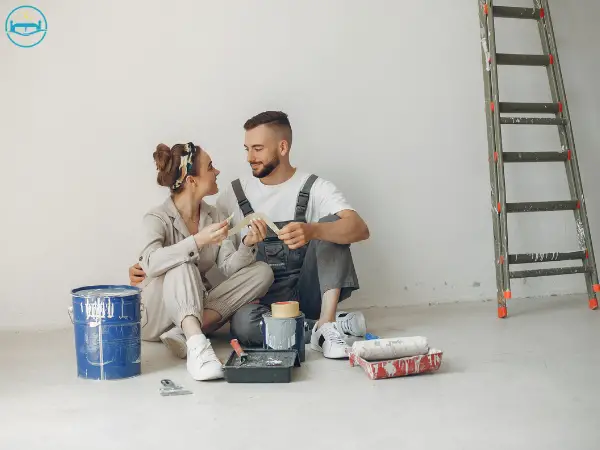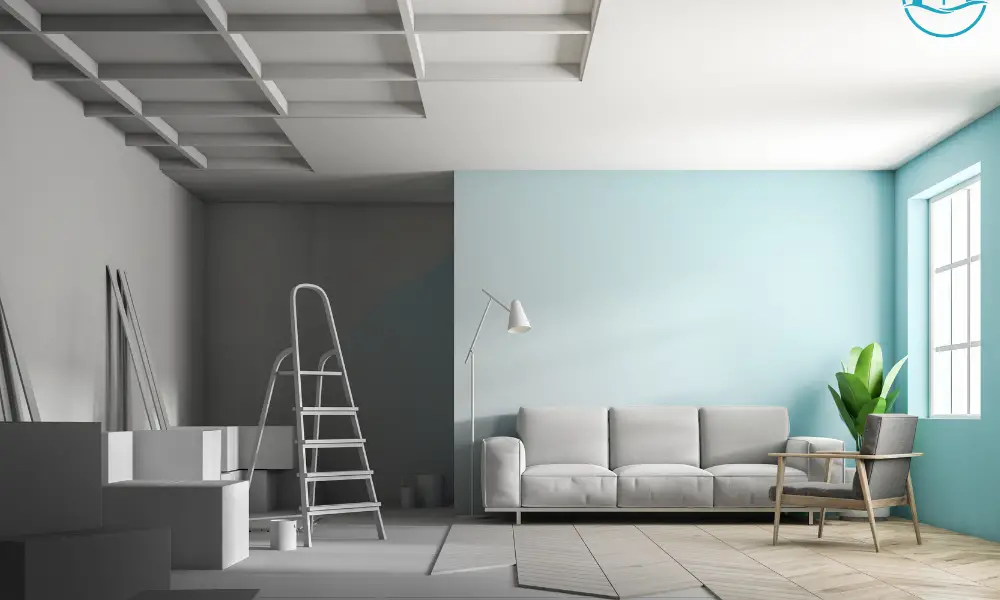Sleeping in a freshly painted room can be harmful due to volatile organic compounds (VOCs). It is advisable to wait until the paint has fully dried and the fumes have dissipated.
Painting a room can transform its appearance, but the aftermath often leaves behind a cocktail of chemicals in the air, known as VOCs.
Manufacturers often suggest waiting at least 24 to 48 hours before occupying a freshly painted room, but this can vary depending on the type of paint used and the room’s ventilation.
Health Risks
Many people wonder about the safety of sleeping in a room that’s just received a fresh coat of paint. It’s a common concern, especially when considering the health risks that might come with inhaling paint fumes. The smell of new paint can be pleasant to some, but it can also hide potential dangers.
Impact Of Volatile Organic Compounds (vocs)
Paints often contain volatile organic compounds, known as VOCs. These are chemicals that can vaporize and enter the air at room temperature. The impact of VOCs on health can be significant and may include:
- Eye, nose, and throat irritation
- Headaches and dizziness
- Nausea
- Worsening of asthma symptoms
Long-term exposure to high levels of VOCs can lead to more serious health issues, such as liver, kidney, or central nervous system damage. It can even increase the risk of cancer. Below is a table highlighting the common VOCs found in paint and their potential effects:
| VOC | Potential Health Effects |
|---|---|
| Formaldehyde | Nasal and eye irritation, increased risk of asthma and allergies |
| Benzene | Headaches, dizziness, increased risk of leukemia |
| Toluene | Skin irritation, headaches, damage to the nervous system |
| Xylene | Nausea, heart problems, and possible effects on the liver and kidneys |
It’s essential to ensure good ventilation in any freshly painted room and wait the recommended time before sleeping in it to minimize exposure to VOCs.
Potential Allergic Reactions
Allergies can be triggered by various substances, including those found in paint. Common allergic reactions to paint fumes might include:
- Skin rashes or hives
- Itchy eyes
- Runny or stuffy nose
- Difficulty breathing
People with existing allergies or respiratory conditions are at a higher risk. The following table outlines potential allergens in paint and their effects:
| Allergen | Effects |
|---|---|
| Latex | Skin irritation, respiratory problems |
| Epoxy Resins | Skin allergies, asthma-like symptoms |
| Preservatives | Contact dermatitis, blistering |
| Fungicides and Biocides | Skin and eye irritation, breathing difficulties |
It’s vital to check the paint label for allergens and choose paints labeled as low-VOC or non-toxic. Always follow the manufacturer’s guidelines for safe use and room reentry times.

Safety Precautions
Are you wondering about the risks of sleeping in a room with fresh paint? It’s important to take safety precautions to ensure your health. Let’s explore how to keep safe when your room gets a fresh coat.
Ventilation And Air Quality
Keeping the air clean is key after painting a room. Paint fumes can linger and may cause headaches or dizziness. To protect yourself, remember these tips:
- Open windows: This lets fresh air in and helps clear out paint odors.
- Use fans: Fans help circulate air, moving fumes out of the room faster.
- Take breaks: Spend time outside to breathe in fresh air.
Here’s a table that outlines the minimum ventilation time based on different paint types:
| Paint Type | Minimum Ventilation Time |
|---|---|
| Oil-based Paint | 24-48 hours |
| Latex Paint | 3-4 hours |
Note: These times can vary based on room size and ventilation rates.
Use Of Low-voc Or Zero-voc Paints
Choosing the right paint is vital for your health. VOCs or Volatile Organic Compounds can be harmful. Here’s why low-VOC or zero-VOC paints are a better choice:
- Fewer fumes: These paints release fewer harmful chemicals into the air.
- Healthier option: They reduce the risk of headaches, allergies, and asthma.
- Quick to settle: They often dry faster and have less odor, so you can return to your room sooner.
Let’s compare traditional paints to low-VOC and zero-VOC paints:
| Type of Paint | VOC Level (grams per liter) | Drying Time |
|---|---|---|
| Traditional Paint | 50-250 | Longer |
| Low-VOC Paint | <20 | Shorter |
| Zero-VOC Paint | 0-5 | Shortest |
Remember: Always check the paint label for VOC levels before buying.
Duration To Wait
Let’s talk about how long you should wait before it’s safe to sleep in a freshly painted room.
Recommended Time Before Sleeping In A Freshly Painted Room
After painting a room, the smell is the first thing you notice. This smell comes from the paint releasing chemicals into the air, a process called off-gassing. It’s important to wait before sleeping in that room. The time you should wait depends on the type of paint used:
- Oil-based paints: These take longer to dry and produce more fumes. It’s best to wait at least 24 hours before using the room.
- Water-based paints: These are less harmful but still need time. A safe waiting period is at least 12 hours.
Here’s a simple table to help you remember:
| Type of Paint | Wait Time Before Sleeping |
|---|---|
| Oil-based | 24 hours |
| Water-based | 12 hours |
Remember, these times are the minimum. If you can wait longer, that’s even better. Always keep the room well-ventilated to speed up the drying process and reduce the smell. Open windows and use fans to circulate fresh air. This not only helps the paint dry but also makes it safer for you to return to the room.
Alternatives For Immediate Use
It’s crucial to consider alternatives for immediate use to avoid these risks and ensure a safe environment. Let’s explore practical solutions for those times when you can’t wait for the paint to completely dry and off-gas.
Temporary Accommodations
Sleeping in a room with wet paint is not safe. Seeking temporary accommodations is a wise choice. Here’s a list of alternatives:
- Stay with family or friends: A night or two could be a mini-vacation.
- Book a hotel room: Ensure a safe, comfortable sleep away from paint fumes.
Consider these factors when choosing a temporary stay:
| Factor | Why It Matters |
|---|---|
| Distance | Close to your home for convenience. |
| Cost | Keep it budget-friendly. |
| Amenities | Look for comforts like Wi-Fi or breakfast. |
Remember to plan for your pets too. They are also sensitive to paint fumes.
Air Purification Methods
Another key strategy is to purify the air. This helps clear out VOCs faster. Here are some methods:
- Open windows: Fresh air dilutes fumes.
- Use fans: Fans boost air circulation.
- Activated charcoal filters: These absorb VOCs effectively.
Devices that can help include:
| Device | Function |
|---|---|
| Air Purifiers | They trap and remove pollutants. |
| Dehumidifiers | Reduce moisture, speeding up drying. |
Combine these methods for best results. Always read the manufacturer’s instructions to ensure proper use of devices.
Special Cases
Pregnant women, children, and people with breathing problems need extra care. Let’s dive into why these groups should avoid freshly painted spaces.
Pregnant Women And Children
Paint fumes can be more than just smelly. They can pose risks during pregnancy and for little ones. Pregnant women and young children are sensitive to chemicals. Here’s why they should steer clear of freshly painted rooms:
- Developing bodies: Children’s bodies are still growing. Harmful chemicals can affect their development.
- Sensitive systems: Pregnant women’s bodies are in a delicate state. Fumes can impact both mother and baby.
Here’s a table to show what’s in some paints and why it’s a concern:
| Chemical | Found In | Risks |
|---|---|---|
| VOCs | Many paints | Can cause nausea and dizziness |
| Lead | Older paints | Can harm brain development |
| Phthalates | Some paints | May affect hormone levels |
It’s best to choose low-VOC or no-VOC paints if possible. Always make sure rooms are well-ventilated. Give paint time to dry and air out before sleeping in the room.
Individuals With Respiratory Conditions
People with asthma or other breathing issues face more risks. Paint fumes can trigger symptoms or even attacks. Here’s what to know:
- Sensitive airways: Fumes can make airways swell and narrow.
- Triggers: Chemicals in paint can start coughing, wheezing, or shortness of breath.
For those with respiratory conditions, consider these tips:
- Wait longer before entering a painted room.
- Use fans and open windows to clear out fumes.
- Wear a mask if you must go in.
- Opt for safer paint options that are low in harmful chemicals.
Remember, your health comes first. Always listen to your body and take steps to keep your air clean and safe.
Frequently Asked Questions
What Happens If You Sleep In A Freshly Painted Room?
Sleeping in a freshly painted room can lead to inhaling harmful fumes. This may cause headaches, dizziness, nausea, and eye, nose, or throat irritation. Always ensure proper ventilation and wait for the paint to fully dry, typically 2-3 days, before using the room to avoid these health risks.
How Long After Painting A Room Is It Safe?
It’s typically safe to occupy a room 2-3 days after painting, allowing for proper ventilation and drying. Always follow the paint manufacturer’s recommendations for optimal safety.
Can A Baby Sleep In A Room That Was Just Painted?
It’s advised to wait at least 2-3 days before letting a baby sleep in a freshly painted room to ensure proper ventilation and air quality.
Can Paint Fumes Harm You?
Yes, inhaling paint fumes can harm your health, potentially causing headaches, dizziness, nausea, and irritation of the eyes, nose, and throat. Long-term exposure may lead to more serious health issues. Always ensure proper ventilation when painting.



